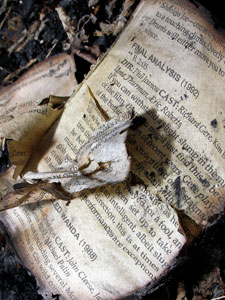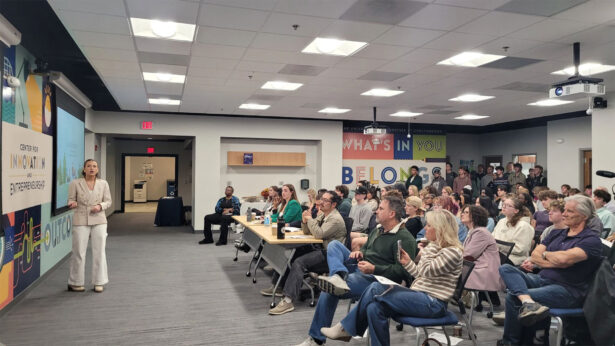By Elizabeth A. Davis
Professor/alumnus perfects the science of forensic fire investigation
To earn a fire safety merit badge, a Boy Scout must learn how to start a fire properly and how to prevent accidental fires. David Icove had no trouble earning this badge as a youngster in the 1960s. He visited the fire department in his hometown of Shaker Heights, Ohio, and was sent to a field where the fire marshal was conducting tests for an arson case he was investigating. The fire marshal was trying to determine the potential height of flames in a trash can stashed under a desk to see if the underside of the desk could catch fire.
Icove was fascinated.
“It turns out the tests he was doing were what only the top scientists were also conducting,” Icove says of the fire marshal’s experiment.
The fire marshal told the young Icove, “There is a field of study called fire protection engineering. It just got going. If you really want a good future in the true science of fire, you’ll pursue this area of study,’” he recalls. “Over the years, I touched base with him, and he kept saying, ‘You should try this.’”
Eventually Icove followed this advice and then some. He can tell you how a fire started, where it started, who started it and sometimes even why.
A nationally recognized fire forensic expert, Icove earned three engineering degrees at the University of Tennessee, Knoxville, including a doctorate, and now serves as a research professor in the College of Engineering. He became so good at profiling arsonists, the FBI hired him, and he developed the criminal profile that helped catch Ted Kaczynski, more famously known as the Unabomber.
It’s not an accident
If you said Icove wrote the book on fire investigation, you’d be right. Except that Icove is the co-author of more than one textbook — three, in fact: Kirk’s Fire Investigation, Forensic Fire Scene Reconstruction and Combating Arson-for-Profit.
In 40 years of investigating fires, Icove has been involved in many intriguing cases. He has gathered mounds of data on fires by examining fire scenes, computer fire modeling and testing in a lab, and interviewing arsonists and bombers in prison. Fire investigation comes down to one staple — the scientific method. Eventually, the evidence and data will show what happened.
 For example, Icove was asked to work a case involving a man who supposedly died in a car fire in Mexico. It just so happened the man recently had taken out two life insurance policies totaling $7 million. The insurance companies were skeptical, and Icove confirmed their suspicions.
For example, Icove was asked to work a case involving a man who supposedly died in a car fire in Mexico. It just so happened the man recently had taken out two life insurance policies totaling $7 million. The insurance companies were skeptical, and Icove confirmed their suspicions.
In July 1998, Mexican police believed they had discovered the body of Madison T. Rutherford, a successful young investment manager from Connecticut, in a burned Chevrolet Suburban on the side of the road.
UT’s famed forensic anthropologist Bill Bass also worked on the case. He examined the body, which he was able to prove was not Rutherford but instead a 50- or 60-year-old Mexican man. Icove investigated the remains of the vehicle and, more than a year after the incident, was able to conclude the fire was intentionally set because of the way the vehicle burned. Icove’s investigation determined the accident was staged to look like the Suburban drove off the road, hit an embankment and burst into flames. But the vehicle burned the hottest in the back instead of the front, where it would have hit the embankment, and there was evidence an accelerant was used.
The insurance companies refused to pay out the policies. Icove suggested that, since Plan A, the faked accident, didn’t work, there would be a Plan B. And, not long afterward, a knapsack reportedly belonging to Rutherford was discovered with a note saying he had been kidnapped and died in an accident.
But by this time, authorities were on the trail of Rutherford, who was eventually found using an alias and working in Boston. He was convicted and sentenced in 2001 to five years in prison.
All fires lead to Knoxville
Icove earned a bachelor’s degree in electrical engineering at UT Knoxville in 1971. That year he went to work for the Navy in Hyattsville, Md., as a civilian and joined a local volunteer fire department. There he met a University of Maryland professor who taught fire protection engineering.
Icove completed a master’s degree in electrical engineering at UTK in 1973, focusing on fire patterns from data he helped gather in Prince George County, Md. At the same time he started his doctorate, a friend became state fire marshal and asked Icove to help investigate some arson fires in East Tennessee.
“I was in my doctoral program — at night taking classes — and working full-time during the day as an arson investigator for the state,” he says.
“Every time the Unabomber would strike, I would travel to the field to get a first-hand look at the crime scenes.”It turns out Icove was very good at figuring out who was setting the fires, and it caught the attention of the FBI. In the early 1980s, the FBI added arsonist profiling to the behavioral science program based in Quantico, Va. That’s where Icove worked for nine years, a timeframe that overlapped with the investigation of the Unabomber. From the first homemade bomb at the University of Chicago in 1978, the Unabomber was responsible for killing three people and injuring 24 over a span of 18 years.
“The first serious profile of the Unabomber looked at a myriad of things he was doing,” Icove says. “Every time he would strike, I would travel to the field to get a first-hand look at the crime scenes, actually examine the devices and to gather information to update the Unabomer’s profile.”
In the early 1990s, there was a series of devastating fires at Tennessee Valley Authority power plants, and the agency needed some experienced professionals to help establish a new police force with jurisdiction on TVA land. Icove transferred to TVA to help with both, returning to the FBI to serve on the Joint Terrorism Task Force in the wake of the Sept. 11, 2001, attacks until his retirement in 2005.
While at TVA, Icove began teaching at UT and got involved in research through the College of Engineering. He also retired from TVA in 2005 and has continued his appointment at the university, where he continues to seek funded research grants and write textbooks. Icove also has developed high-performance computer systems that model fires — from as simple as the trash can fire his hometown fire marshal was testing in the 1960s to fires in today’s complex multi-story warehouses.
More forensic fire-engineering and computer fire-modeling research is needed. While fire investigation techniques have become more sophisticated, fires have become more destructive, Icove says.
“Furniture materials are not the same as they were 25 years ago. Today they often produce more heat in a shorter period of time,” he explains. “Trying to figure it out is more complicated and more challenging.”
Icove has a small office in the new Min H. Kao Electrical Engineering and Computer Science Building. If you’re there long enough, you might detect a faint odor of smoke.



